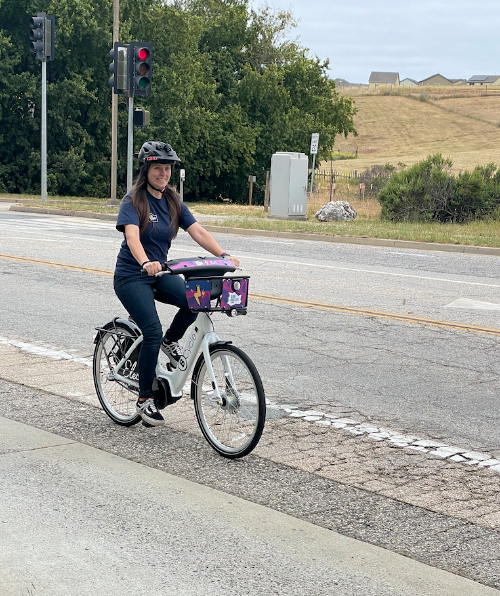Campus News
Cruzin’ to Campus: Five Essential Bicycle Safety Tips for Slugs
Safety should always be a top priority when pedaling your way across campus and around the city.

With fall quarter underway, UC Santa Cruz is bustling with students walking to class, biking to the library, and riding city buses downtown.
With the successful launch of the regional BCycle e-bike share program at UC Santa Cruz and within the City of Santa Cruz, and the continuing popularity of e-bikes, many students are learning that bicycles are one of the best ways to get around–and for good reasons. Biking is an eco-friendly, cost-effective, and convenient way to travel. Also, UC Santa Cruz recently received a GOLD designation from the League of American Bicyclists’ Bicycle Friendly University program. However, safety should always be a top priority when pedaling your way across campus and around the city. To help ensure that university students have a safe and enjoyable biking experience, here are five essential bicycle safety tips:
1. Wear Proper Safety Gear
One of the most critical aspects of bicycle safety is ensuring that you have the right safety gear. Always wear a well-fitted helmet that meets safety standards, such as CPSC or ASTM. Your helmet is your first line of defense in case of a crash, so make sure it’s snug and properly fastened. An improper fit can compromise protection (and your willingness to wear a helmet), so get the right size and adjust it properly. Also, look for a bike helmet that matches your style of riding. Most riders will be fine with a recreational helmet, but if you plan on mountain biking or perhaps investing in a higher-end road bike, you may consider a more specialized piece of headgear.
Recreational helmets are available to all students and employees at no additional cost to them. Slug Bike Life has two events per quarter for helmet and light giveaways, or sign up to get a helmet from TAPS (events held every Friday during instruction). Additionally, reflective clothing and accessories can significantly increase your visibility, especially during dawn and dusk rides. Consider investing in reflective vests, ankle bands, and lights for both the front and back of your bike to make sure others can see you clearly on the road.
2. Follow the Rules of the Road
Bicycles are considered vehicles, and as such, cyclists must obey traffic laws just like drivers of other vehicles. Always ride in the same direction as traffic, and obey traffic control devices, including always coming to a complete stop at stop signs and red lights, signaling when turning, changing lanes, or stopping, by using hand signals to indicate your intentions. Make sure to yield the right-of-way to pedestrians, announce your presence verbally or with a bell when passing pedestrians and slow down when approaching blind turns, crosswalks or intersections. Avoid riding on sidewalks or pedestrian paths, as it can create unexpected hazards for pedestrians.
In addition to these rules for all cyclists, e-bikes have some additional considerations. E-bikes are heavier than traditional bikes; they take longer to stop and some can build more speed when going downhill. When approaching a stop, brake early and squeeze BOTH brake handles. When descending a hill, squeeze both brake handles gently to maintain a safe speed.
3. Regular Maintenance Checks
Regular bicycle maintenance is key to ensuring your bike is in good working order. Before each ride, perform the ABC Quick Check:
Air: check your tires for proper inflation and make sure they are free of cuts or punctures. Brakes: Ensure your brakes are functioning correctly
Chain: Examine your chains to make sure it’s free of rust and has the proper tension.
Quick: If your bike has quick release wheels, make sure that the release is closed before riding.
Check: Make sure lights and reflectors are clean and visible and do another once-over of your bike.
If you’re not comfortable doing these checks yourself, sign up for a free mechanic check event with Slug Bike Life, make an appointment to stop by the Bike Co-op, or visit a local bike shop for routine maintenance and safety inspections. A well-maintained bike is less likely to malfunction, reducing the risk of accidents.
4. Be Mindful of Weather and Roadway Conditions
Weather can change rapidly, and it’s essential to adjust your riding style to the conditions. Moisture can make roads slippery, so reduce your speed and increase your following distance in adverse conditions. Make sure your tires have adequate tread for wet conditions. Visibility can also be challenging, especially with thick marine layers, so use your lights and wear bright, waterproof clothing. When the weather gets really severe, consider alternative transportation options to ensure your safety. Pay particular attention to downhill grade roads which can increase speed and stopping distances.
5. Stay Alert and Avoid Distractions
Distractions are a significant safety concern for cyclists. Just as with driving a car, texting, talking on the phone, or wearing headphones while biking can lead to crashes. Stay focused on the road, keep both hands on the handlebars, and be aware of your surroundings. Watch out for parked cars, pedestrians, and other cyclists, and always anticipate potential hazards. Avoid the temptation to use your phone or engage in other distractions while riding.
Cycling is a fun and efficient way to navigate your university campus and it’s crucial to prioritize safety at all times. Wearing the right safety gear, following the rules of the road, conducting regular maintenance checks, being mindful of weather conditions, and staying alert and free from distractions are all essential components of safe cycling. By adopting these practices, Slugs will have a safer and more enjoyable biking experience at UC Santa Cruz and beyond.